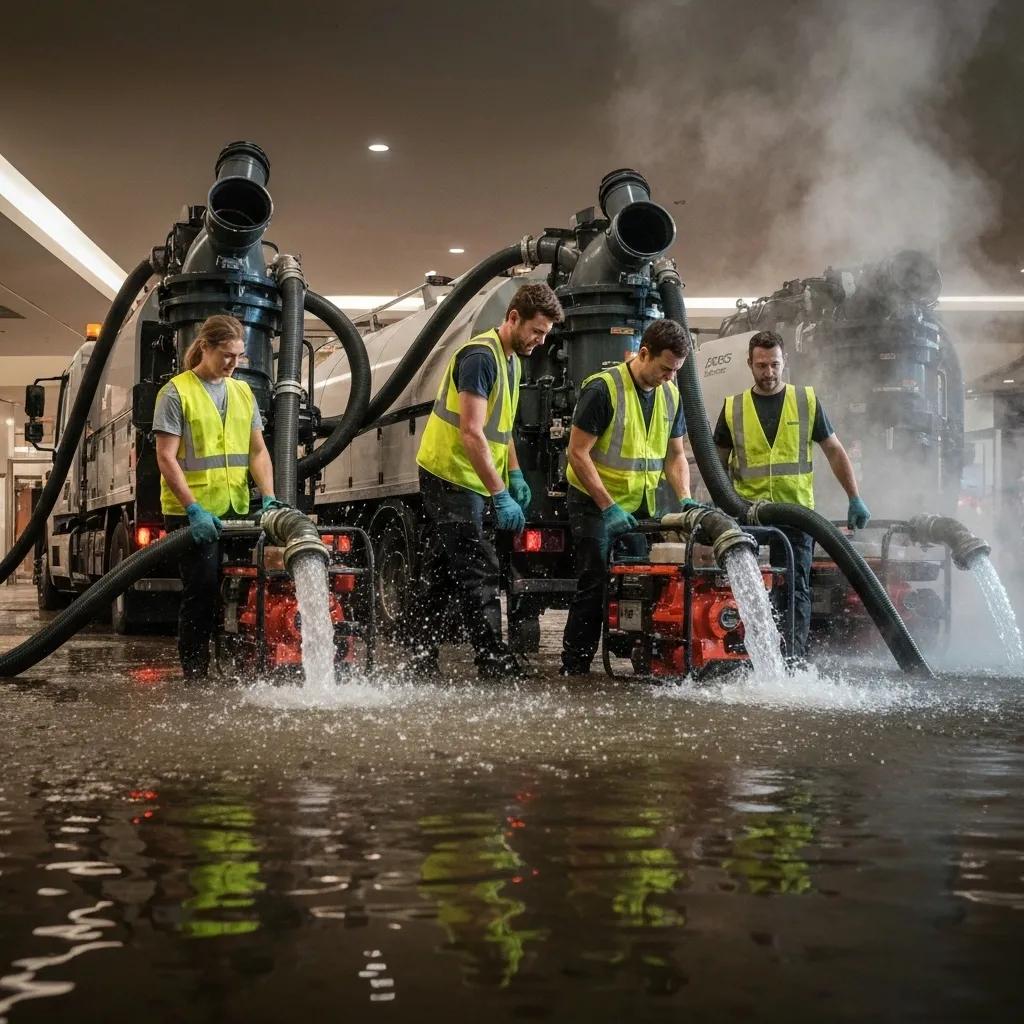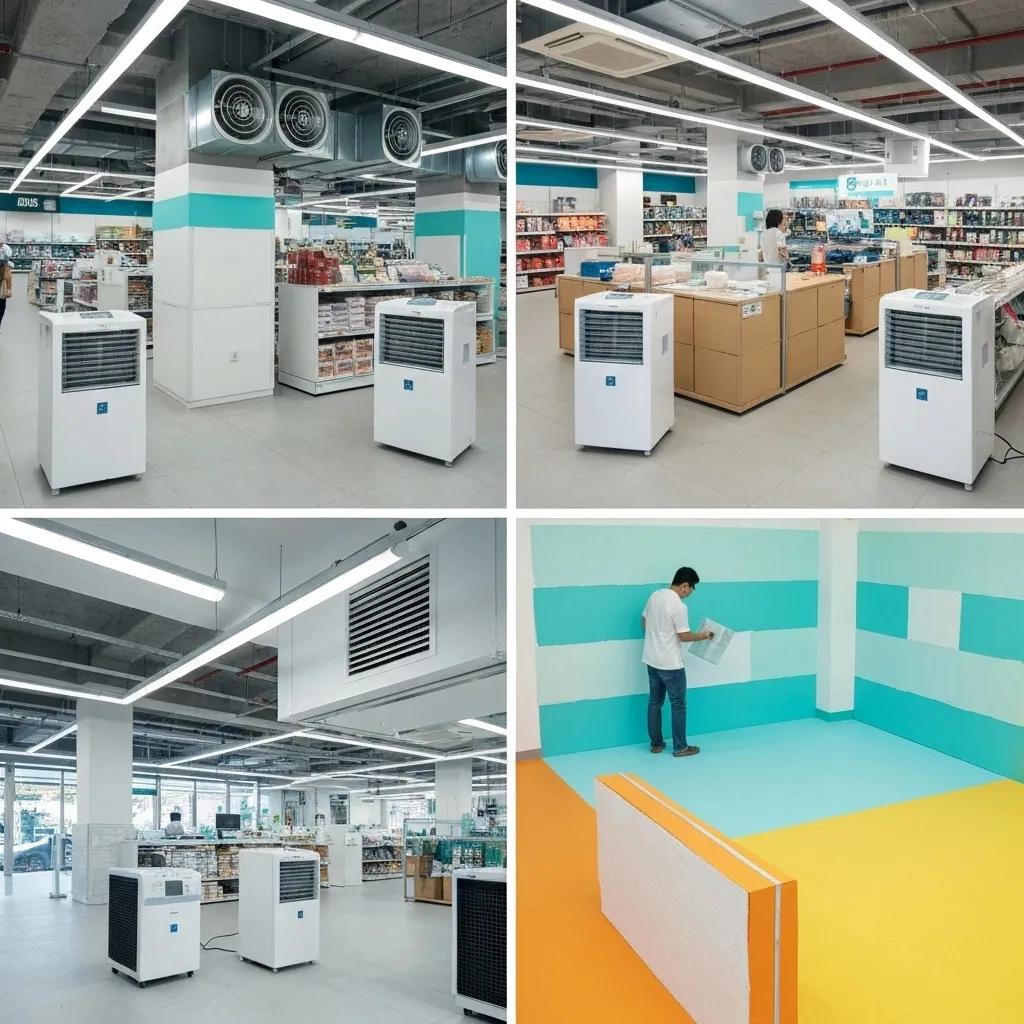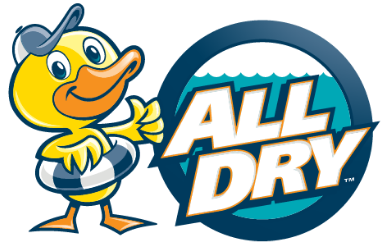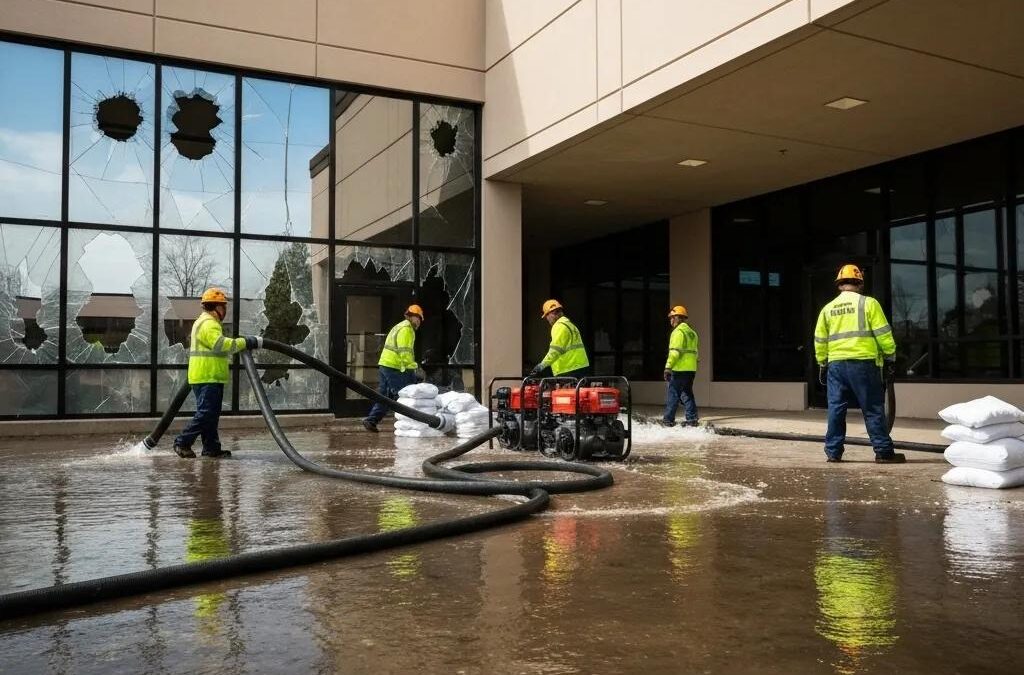Commercial Flood Damage Cleanup: Essential Strategies for Effective Business Water Damage Restoration
Commercial flood damage cleanup demands immediate action to protect assets, minimize downtime, and safeguard employee and customer safety. By applying a structured remediation process—starting with rapid water removal and ending with certified structural repairs—businesses can restore operations faster and avoid secondary issues like mold. This guide covers five critical themes: understanding commercial flood damage, step-by-step cleanup strategies, future prevention planning, insurance and claims guidance, and selecting the right restoration partner. Alongside expert procedures, we illustrate how All Dry Services of Las Vegas — a 24/7 emergency water damage restoration team — supports businesses with industry-leading expertise and rapid response.
What Is Commercial Flood Damage and How Does It Impact Businesses?
Commercial flood damage occurs when uncontrolled water intrusion from storms, broken pipes, or wastewater breaches a business facility and impairs structural and operational elements. Rapid inundation jeopardizes equipment, inventory, and critical data systems, leading to costly interruptions and safety hazards. Understanding categories of water contamination and asset exposure lays the foundation for targeted remediation.
What Are the Types and Categories of Commercial Water Damage?
Commercial water damage falls into three contamination categories defined by the IICRC:
Each category dictates protective gear, disposal protocols, and sanitation measures to prevent cross-contamination and health risks. Recognizing these classes informs the selection of appropriate extraction and treatment methods, ensuring no hidden hazards remain.
How Does Flood Damage Affect Commercial Property Assets?
Floodwater can sever power to servers, warp wooden fixtures, and saturate stockroom shelving, putting all physical and digital assets at risk. Critical enterprise systems—such as point-of-sale terminals and network switches—must be evaluated for electrical safety and corrosion before reactivation. Equipment downtime directly translates into lost revenue, making swift assessment and asset triage essential to retain operational continuity.
Why Is Rapid Response Critical for Minimizing Business Flood Loss?
Immediate action curbs secondary damage like mold proliferation, structural weakening, and swelling of porous materials. In perishable goods environments, standing water also accelerates microbial growth. Engaging a professional team within the first 24 hours reduces restoration costs by up to 50%, preserves brand reputation, and upholds compliance with safety regulations. Rapid response ultimately limits interruption and positions businesses for faster recovery, setting the stage for detailed cleanup protocols.
Commercial Flood Damage Cleanup: Key Business Restoration Strategies
An optimized cleanup process integrates rapid assessment with industry-approved techniques to remove water, dry structures, sanitize surfaces, and restore integrity. Following IICRC S500 guidelines ensures consistency and efficacy at every phase.
How Does Emergency Commercial Water Extraction Work?

Emergency extraction uses high-capacity submersible pumps and truck-mounted vacuums to eliminate standing water swiftly. Technicians place extraction units strategically to maximize flow rate, preventing water from migrating to adjacent zones. Once bulk removal is complete, portable extractors with heated suction deliver thorough moisture lift from carpets and flooring. Proper extraction reduces drying times and limits further material degradation.
What Are the Best Practices for Commercial Property Drying and Dehumidification?
Effective drying employs a combination of air movers and dehumidifiers to lower humidity below 45% within 48 hours. Industrial air movers create laminar airflow across wet surfaces, while low-grain refrigerant dehumidifiers capture airborne moisture. Strategic fan placement and continuous monitoring with thermo-hygrometers guarantee uniform drying.
Balancing dehumidification capacity with airflow promotes structural drying without over-drying sensitive materials. This combined approach underpins mold prevention and structural safety.
How Is Sanitization and Mold Prevention Handled After Flood Cleanup?
Post-drying sanitization uses EPA-registered antimicrobial agents to neutralize bacteria and inhibit mold spores on walls, ceilings, and HVAC components. Technicians apply fogging and spray techniques to reach hidden cavities. Mold-resistant coatings may be added to drywall and wood framing as a proactive barrier. Continuous moisture monitoring during a 72-hour cure period confirms treatment success and prevents resurgence.
What Structural Repairs Are Needed Post-Flood Damage?
Reconstruction begins with removal of irreparably damaged drywall, flooring, and insulation, followed by framing restoration and moisture-proofing. Common repairs include:
- Replacing saturated sheetrock up to flood line.
- Installing new subfloor and moisture-resistant underlayment.
- Refinishing surfaces with water-tolerant primers and paints.
- Reinforcing structural lumber with epoxy-based wood consolidants when possible.
Adhering to local building codes and standards maintains compliance and ensures long-term stability of the repaired structure.
How Do IICRC Standards Guide the Cleanup Process?
IICRC S500 defines procedural steps, documentation requirements, and performance benchmarks for water damage restoration. By following these standards, technicians deliver consistent, verifiable outcomes. Compliance also simplifies insurance negotiations, as carriers often require evidence of IICRC-aligned practices. Integrating photographs, moisture readings, and treatment logs supports transparent reporting and quality control.
How Can Businesses Prepare for and Prevent Future Flood Damage?
Proactive planning and infrastructure upgrades reduce the likelihood and impact of future incidents. A strong preparedness plan integrates environmental modifications, maintenance schedules, and continuity protocols.
What Are Effective Mold Prevention Strategies in Commercial Buildings?

Controlling indoor humidity below 60% and ensuring proper ventilation in basements, storage areas, and restrooms inhibits mold growth. Installing continuous-run exhaust fans, sealing foundation cracks, and applying mold-inhibiting treatments on HVAC drip pans create multiple defense layers. Regular inspections of wet areas and early remediation of leaks further fortify mold control.
How Should Businesses Develop Flood Preparedness and Continuity Plans?
A robust flood prep plan includes risk assessment, emergency contact lists, data backup protocols, and relocation agreements. Key steps involve:
- Conducting site-specific vulnerability analyses for flood sources.
- Establishing predefined shut-off procedures for utilities.
- Backing up critical data offsite or in the cloud.
- Arranging temporary facility agreements to maintain operations.
Embedding these measures within an actionable continuity manual ensures teams can execute recovery tasks under pressure and minimize revenue loss.
What Specialized Equipment Is Used for Large-Scale Commercial Flood Cleanup?
Industrial-grade tools accelerate remediation in expansive facilities:
- Truck-mounted extraction units for thousands of gallons per hour.
- Desiccant dehumidifiers that operate in low-temperature warehouses.
- Infrared moisture meters and thermal imaging cameras for deep-structure detection.
- High-pressure air filtration systems to control airborne particles during demolition.
Deploying the right machinery enhances efficiency and ensures comprehensive moisture removal in large footprints.
How Do Commercial Flood Damage Insurance Claims Work?
Navigating commercial flood insurance demands precise documentation and awareness of policy terms. Proper claim preparation streamlines payout processes and minimizes disputes.
What Documentation Is Required for Commercial Flood Insurance Claims?
Comprehensive evidence includes:
- Pre-loss photographs of affected areas and assets.
- Water damage category assessments by certified technicians.
- Moisture and drying logs with time-stamped readings.
- Itemized repair estimates and contractor invoices.
Compiling this information in an organized claim packet reduces back-and-forth with carriers and accelerates settlement.
Who Pays for Commercial Water Damage Restoration?
Responsibility depends on policy coverage:
- Flood insurance riders typically cover flood-related losses.
- Standard property policies address burst-pipe or sprinkler system events.
- Business interruption endorsements compensate for lost income during repairs.
Understanding policy inclusions and exclusions helps businesses budget for deductibles and negotiate coverage for specific damage scenarios.
How Can Businesses Maximize Insurance Payouts for Flood Damage?
To optimize claims, businesses should:
- Report incidents immediately and document every communication.
- Engage IICRC-certified professionals for assessment and remediation.
- Maintain detailed logs of mitigation efforts to demonstrate loss reduction.
- Review policy limits and exclusions with a knowledgeable agent before filing.
Active engagement with insurers and adherence to documented standards positions companies for fair compensation and swift fund disbursement.
Why Choose All Dry Services of Las Vegas for Commercial Flood Damage Cleanup?
All Dry Services of Las Vegas combines local expertise with advanced techniques to deliver seamless restoration. As a 24/7 emergency response team, All Dry LV minimizes downtime and ensures businesses return to full operation faster.
What Are the Unique Benefits of All Dry LV’s 24/7 Emergency Flood Response?
Immediate dispatch of certified technicians ensures water removal begins within hours of notification. With round-the-clock availability, All Dry LV prevents secondary damage and secures the property perimeter. Emergency response vehicles are fully stocked with industrial pumps and drying equipment to address any scale of flood event.
How Do Certified Technicians Ensure Quality Commercial Water Damage Restoration?
All Dry LV’s staff hold IICRC certification in water damage restoration and mold remediation. These credentials guarantee adherence to S500 standards and professional documentation. Trained in advanced moisture detection and structural drying protocols, technicians deliver consistent, measurable results that support insurance claims.
What Do Local Business Case Studies Reveal About All Dry LV’s Effectiveness?
Las Vegas enterprises across retail, hospitality, and warehousing have benefitted from All Dry LV’s rapid recovery solutions. In one case, a 20,000 sq ft warehouse resumed full operation five days after a Category 3 flood when standard commercial approaches had stalled. Detailed project logs demonstrated successful moisture eradication and structural repair, earning client praise and positive reviews.
What Are the Most Common Questions About Commercial Flood Damage Cleanup?
Business owners often seek clarity on restoration scope, timing, and mold prevention tactics before committing to services. Addressing these concerns builds confidence in professional solutions.
What Is the Typical Timeline for Commercial Flood Damage Restoration?
- Emergency water removal: 1–2 days
- Structural drying and dehumidification: 2–4 days
- Sanitization and mold prevention: 1–2 days
- Structural repairs and finishing: 3–7 days
Prompt initiation of each phase accelerates overall recovery and mitigates extended business interruption.
How Long Does It Take to Dry a Commercial Building After Flooding?
Commercial structures typically require 48–72 hours of continuous drying to reach moisture equilibrium. Continuous monitoring and equipment adjustments ensure that subfloor, wall cavities, and HVAC assemblies achieve safe humidity levels. Delays in drying increase the risk of mold and extended downtime.
How Can Businesses Prevent Mold Growth After Flood Damage?
Mold prevention hinges on achieving sub-50% relative humidity within 24–48 hours and applying antimicrobial treatments to all wetted substrates. Incorporating moisture-barrier paints and routine HVAC maintenance further inhibits spore colonization. Consistent environmental monitoring verifies that mold-favorable conditions never return.
What Should Businesses Do Immediately After a Flood?
First steps include:
- Securing the facility to prevent unauthorized access.
- Shutting down electrical power at the main breaker.
- Photographing the damage for insurance documentation.
- Contacting an IICRC-certified restoration provider.
These actions establish safety controls, preserve evidence, and initiate professional mitigation with minimal delay.
How Can Businesses Request Commercial Flood Cleanup Services in Las Vegas?
When flood emergencies strike, swift service initiation is critical to limit losses. All Dry LV simplifies engagement through clear contact channels and rapid response processes.
How to Contact All Dry Services for Emergency Commercial Water Removal?
To arrange 24/7 emergency assistance, call All Dry Services of Las Vegas at their central dispatch line or visit the main website for immediate support. Early notification activates the rapid-response team and dispatch vehicles loaded with extraction and drying gear.
What Is the Process to Request a Commercial Flood Damage Cleanup Quote?
Businesses can complete an online form to request service estimates. The request process involves:
- Describing the flood source and affected square footage.
- Scheduling a preliminary onsite inspection.
- Receiving a detailed, IICRC-anchored proposal with scope and costs.
Submitting the form ensures a transparent, no-obligation quote tailored to the specific damage scenario. For a direct inquiry, you can request a commercial flood cleanup quote online.
Where Is All Dry Services Located and What Areas Do They Serve?
All Dry Services of Las Vegas operates from a central Las Vegas facility and serves the entire metropolitan area, including Henderson, Summerlin, North Las Vegas, and Boulder City. Their local presence guarantees rapid arrival times and familiarity with regional flood risks and building codes.
All Dry LV’s combination of certified expertise, specialized equipment, and 24/7 availability positions them as the trusted partner for commercial flood damage cleanup in Las Vegas.
Restoring a flooded commercial property requires precision, speed, and proven methods to protect assets and resume operations. By understanding damage categories, following an IICRC-driven cleanup process, planning for future prevention, navigating insurance efficiently, and choosing a qualified restoration partner, businesses can overcome flood setbacks with confidence. Integrating these strategies ensures comprehensive recovery, reduced downtime, and lasting protection against future water events.

